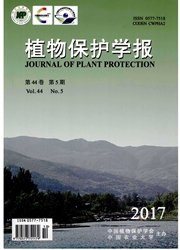

 中文摘要:
中文摘要:
为调查西南地区小麦条锈病抗性、抗病基因位点及其组合多样性,于2013—2014年对以西南地区为主的140份小麦品种(系)进行了成株期、苗期抗病性鉴定和抗病基因标记扫描。成株期鉴定结果显示,2013年贵阳、赫章试验点和2014年贵阳、绵阳试验点都表现为抗病的品种(系)共有50份,其中表现为全生育期抗性的有37份,表现为成株期抗性的有13份;5个抗病基因Yr9、Yr10、Yr15、Yr18、Yr26的分子标记检测结果显示,西南地区小麦Yr26的使用频率最高,为41.4%,Yr9次之为37.9%,Yr10、Yr15、Yr18使用频率较低;抗条锈病基因的组合分析显示,共出现16份基因聚合品种、7种组合类型,其中组合Yr9+Yr26出现频率较高,为5%。表明西南地区的小麦品种(系)以利用全生育期抗性为主,且抗条锈病基因利用较为单一,应发掘和利用新抗条锈病基因及重视多基因的聚合。
 英文摘要:
英文摘要:
To investigate the stripe rust resistance and the resistance gene combinations of wheat in the southwestern China,140 common wheat cultivars(lines),mainly from Guizhou and Sichuan provinces,were collected in this study.The resistance of cultivars(lines) was evaluated by using natural infection at adult plant stage during 2013—2014 and inoculated with mixed races of CYR31,CYR32 and CYR33 at seedling stage in the greenhouse.The results showed that 50 cultivars(lines) were resistant at Guiyang,Hezhang sites in 2013 and Guiyang,Mianyang sites in 2014.Among them,37 were all-stage resistant,and 13 were adult plant-resistant.Meanwhile,the wheat accessions were also tested by six molecular markers linked to the stripe rust resistance genes Yr9,Yr10,Yr15,Yr18 and Yr26.More cultivars were found to carry 41.4% Yr26 and 37.9% Yr9,while fewer cultivars carried Yr10,Yr15 and Yr18.There were 16 cultivars that were pyramided with two or more resistance genes.The two resistance gene combinations were most frequent.Among them,the Yr9 + Yr26 combination had the highest frequency of 5%.The results indicated that all-stage resistance was prevalent in wheat in southwestern China,and stripe rust resistance genes utilization modes were fewer.Therefore,wheat breeders in thisregion should pay more attention to discovery and application of new resistance genes,as well as polygene pyramiding in the future.
 同期刊论文项目
同期刊论文项目
 同项目期刊论文
同项目期刊论文
 期刊信息
期刊信息
